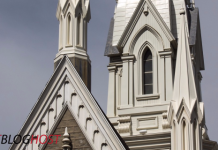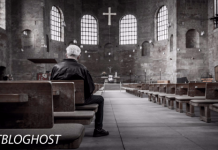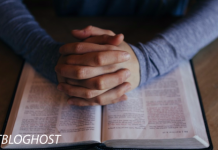My friend Robert Millet wrote an interesting book two years ago, with the title What Happened to the Cross? Bob is a distinguished Mormon theologian who is extensively involved in interreligious dialogue (including the evangelical-Mormon dialogue which he and I co-chair). This book, published by the Deseret Book Company, is addressed primarily to a Latter Day Saints audience, so it is interesting to be able to listen in on what he says to his fellow Mormons about Christ’s redemptive mission.
The very title suggests that Bob wants Mormonism to pay more attention to the Cross of Christ. That the Cross is not a very visible symbol in the Mormon community Millet attributes to the fact that many early Mormon leaders had Puritan roots, and they shared Puritanism’s worries about too much visible symbolism. As he observes, the same was true for many Baptists, who only started displaying crosses when they moved into the Protestant mainstream in the 19th century.
But there is also a theological issue at stake for Mormons—the Mormon focus on what Millet describes as “the central role of Gethsemane.” Mormonism has insisted, he says, “that our Lord’s suffering there [in the Garden] was not simply an awful anticipation of Calvary but that it was redemptive in nature.” Millet does argue, though, that the emphasis on Gethsemane should not detract from the acknowledgement that Christ’s atoning work was” consummated” on Calvary. He cites the late Gordon Hinckley in this regard. In 2005 the LDS president put it clearly: it was on the Cross of Calvary that “our Savior, our Redeemer, the Son of God, gave Himself, a vicarious sacrifice for each of us.”
Obviously there is much to discuss here with our Mormon friends. At the very least, though, it should be clear that the “counter-cult” folks have not been fair when they have insisted that for Mormonism, Christ’s redemptive mission was somehow accomplished exclusively in Gethsemane. Ed Decker and Dave Hunt, for example, are bearing false witness when they state bluntly, in The God Makers, that “Mormons have an almost fanatical aversion to the cross and the shed blood of Jesus Christ.” Bob Millet’s book provides overwhelming evidence to the contrary.
Actually, there are good reasons why we evangelicals ought ourselves to pay closer attention to Gethsemane as an important stage in Christ’s redemptive mission. For anyone looking for a solid Reformed basis for that claim, here is question and answer 37 of the Heidelberg Catechism, commenting on the “he suffered” phrase in the Apostles Creed:
Q. What do you confess when you say that He suffered?
A. During all the time He lived on earth, but especially at the end, Christ bore in body and soul the wrath of God against the sin of the whole human race. Thus, by His suffering, as the only atoning sacrifice, He has redeemed our body and soul from everlasting damnation, and obtained for us the grace of God, righteousness, and eternal life.
Christ paid the debt for our sin “especially at the end,” but the transaction began much earlier. Carrying the burden of our sins in his own person was not merely a three-hour affair. It began in Bethlehem, and it certainly was experienced in an especially intense way when he sweat drops of blood in the Garden. This means that we have some common themes to build on in our dialogues with Mormons. More importantly, it means that a focus on Gethsemane can be a worthy exercise in our own spiritual formation.
2 Comments »
-
Dr. Mauw wrote: That the Cross is not a very visible symbol in the Mormon community Millet attributes to the fact that many early Mormon leaders had Puritan roots, and they shared Puritanism’s worries about too much visible symbolism. As he observes, the same was true for many Baptists, who only started displaying crosses when they moved into the Protestant mainstream in the 19th century.
I respond: With all due respect to Dr. Millet, the theory he proposes is not an accurate explanation, as it falsely assumes that the LDS cross aversion has always existed. Although it is true that early 19th century American Protestants avoided the cross at the time the LDS Church was first being established, and although it is true Mormons have echoed the same protestant anti-cross polemics of the past, it is NOT true that these shared negative perceptions were contemporary. The mainstream Protestant contention towards the cross teetered out around the 1840s and 50s, while the LDS contention didn’t even START until a generation or two later. The LDS cross aversion started at the grass-roots level around the turn of the 20th century, and later became institutionalized as protocol in the 1950s under the direction of President David O. McKay, on grounds that the cross was a purely “Catholic” tradition. Prior to this time, several prominent Saints (including Church authorities) embraced and promoted the symbol of the cross. The cross was a common floral display in LDS funerals, for example; and in 1916 the Church had even petitioned the SLC Council to erect a cross monument on Ensign Peak.
I am a grad student writing my MA thesis on the development of the LDS cross aversion, which will be finished this April. The thesis explains why Mormons did not initially buy into the anti-cross polemics common to American Protestantism of the early 19th century, and will also explain why the LDS perception of the cross evolved to become what it is today.
Comment by Michael G. Reed — March 10, 2009 @ 12:29 pm
-
Dr. Mouw,
Thanks for bringing attention to this new book by Dr. Millet. As someone who grew up a 5th generation Mormon, but now an Evangelical Christian (and Fuller Grad!) I have watched your dialogue and discussions with Mormon leaders / scholars with keen interest.
Your (and others) efforts have helped replace the viscous tracts, ridiculous videos, and hate literature with meaningful dialogue that seeks to go beyond stereotypes and fear of the unknown. As someone who seeks to have meaningful conversations with my friends and family I have been able to use your efforts as a foundation and example to guide my interactions.
I am very encouraged that Dr. Millet is willing to engage this issue and hope that it spurs thought and research in both the Christian and Mormon community.
I will say that when I was growing up (1980s) there was a sharp aversion to the cross. Almost a repulsion to it as a symbol. I don’t remember why, but I do remember countless Sunday school lessons on the importance of Gethsemane. I assumed (at the time) that we didn’t wear crosses because we didn’t want to be thought of as Catholics. We wore our CTR rings because we were Mormon.
I must say though, I have noticed, in the last 10 years, that aversion has lessened a great deal. Its not like my Dad and Mom are now wearing cross necklaces and t-shirts, but my family as a whole seems much more comfortable engaging dialogue about the cross / redemption.
Thank you again for your work.
Comment by Kyle Costello — March 13, 2009 @ 11:32 am






























